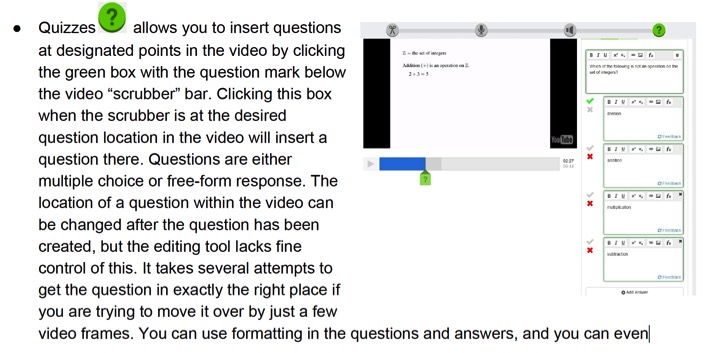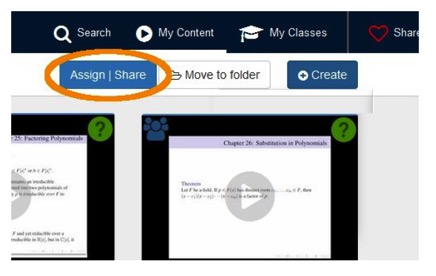Darin Stephenson, Professor of Mathematics, Hope College (e-mail: stephenson@hope.edu)
For teaching my “flipped classroom” version of Math 341 at Hope College, I had created many lecture videos for the students to watch outside of class. I wanted a way to embed quiz questions into these videos so that I could find out how well students were understanding the lecture  material. The EDpuzzle website (https://edpuzzle.com ) has filled this need nicely. This blog post will explain how to create video quizzes in EDpuzzle, how to assign them to your students, and how to track your students’ progress. I will also comment on the ease of use of the editing and course tools, as well as what I’d like to see in future iterations of this tool.
material. The EDpuzzle website (https://edpuzzle.com ) has filled this need nicely. This blog post will explain how to create video quizzes in EDpuzzle, how to assign them to your students, and how to track your students’ progress. I will also comment on the ease of use of the editing and course tools, as well as what I’d like to see in future iterations of this tool.
The first time you go to EDpuzzle, you’ll need to create a free account. You’ll need to choose whether you are creating a teacher account or a student account, and you’ll be asked for some basic information (such as your name and e-mail address). Some enhanced grading features are available with a paid EDpuzzle account.

Making an EDpuzzle quiz requires starting with an existing video.
When you log in as a teacher and choose the “My Content” tab,
you can click the “Create” button either to upload a video from
your personal computer or to load a video that is available on the
internet (by specifying the video’s web address or searching one
of several possible sites such as YouTube and Vimeo). I wanted
to get one of my own videos which is already posted on YouTube,
so I pasted its web address into the search bar in EDpuzzle.

Once the video is loaded, you are presented with four basic editing tools: Crop, Audio Track, Audio Notes, and Quizzes.

that play at specific places in the video.
Since my videos were already cropped and had a complete audio track, I only used Quizzes.

input mathematical equations using the equation editor or LaTeX code. When you have added all of the questions that you want (and have made sure they are in the correct locations) click “Finish” to save your video quiz. You can edit the quiz later until it is actually assigned to students.
Creating and Managing a Class
After you have created one or more video quizzes, you can create a class to assign them to. From the main EDpuzzle window, choose the My Classes tab to view your existing classes or create new classes.

 Once you have created a class, go back to the My Content tab, select a video, and click the Assign/ Share button to assign the video to one or more classes and set due dates. The final step is to get your students connected to your class. Each student will need to create a student account on EDpuzzle. (You might want to have them use their real name and/or official institutional e-mail address so that it is easier to identify them.)
Once you have created a class, go back to the My Content tab, select a video, and click the Assign/ Share button to assign the video to one or more classes and set due dates. The final step is to get your students connected to your class. Each student will need to create a student account on EDpuzzle. (You might want to have them use their real name and/or official institutional e-mail address so that it is easier to identify them.)
The  button on the My Classes tab will provide you with a course code to share with your students. After your students have created their EDpuzzle accounts and have logged in, they can use the course code to access your course. You can track your students’ progress on assignments. EDpuzzle will tell you what percentage of a video each student has watched and each student’s score on the quiz questions. You can also sort by question to see how many students have missed a specific question. EDpuzzle will keep track of your students’ grades on each assignment, and the grades can be exported to a .CSV file (which can be opened in a spreadsheet program such as Microsoft Excel).
button on the My Classes tab will provide you with a course code to share with your students. After your students have created their EDpuzzle accounts and have logged in, they can use the course code to access your course. You can track your students’ progress on assignments. EDpuzzle will tell you what percentage of a video each student has watched and each student’s score on the quiz questions. You can also sort by question to see how many students have missed a specific question. EDpuzzle will keep track of your students’ grades on each assignment, and the grades can be exported to a .CSV file (which can be opened in a spreadsheet program such as Microsoft Excel).
Pros, Cons, and Desired Features
I found the EDpuzzle tool to be easy to learn and use. It was relatively straightforward to accomplish the tasks I wanted to accomplish, and the tool tracks student performance in helpful ways. Students also found the sign-up process to be reasonably easy, and the video/quiz interface seems to make sense to them. (For faculty using Moodle in their courses, video quizzes can also be embedded from EDpuzzle directly into a Moodle page, so that the students can find everything very easily.)
There are a few drawbacks of using EDpuzzle, and these could be improved in future versions.
● The tool lacks fine control as to where questions are placed. It is often hard to get the question in exactly the right spot in the video, and it is hard to move the question incrementally within the video once you’ve misplaced it. (I haven’t tried cropping video in EDpuzzle, but I assume similar issues exist with cropping at the right spot.)
● I often want to place questions at locations where there is a pause in the audio track — at the end of a slide or between sentences. It would help to have a separate audio track meter that shows where these pauses are, and that would help with proper questions placement. There were several occasions when I intended to put a question at the end of a slide only to find that the question ended up in the middle of the last sentence of the slide’s audio.
● It would be great to be able to save questions for future use in other quizzes. It would also be ideal to be able to save answer templates for the multiple choice questions. I gave several True/False questions, but had to create the two responses “True” and “False” every time.
● Documentation for the tool is still a little sketchy at this point and largely exists within YouTube videos. The videos are great for learning to use the tool, but not as helpful if you want to look up how to do a specific thing.
● The documentation isn’t entirely clear about how answers behave in multiple choice questions — for example, is the answer order randomized or is it the same for every student? It might also be nice to be able to allow students multiple tries on questions. As it is configured currently, students get one try on every quiz question and then cannot answer that question again.
The tool allows for automatic feedback for each quiz question, dependent upon which answer the student selects. The instructor can also go in and give individual feedback on student answers.
Summary
Overall, EDpuzzle is a helpful, free tool that is reasonably easy to learn and use for both students and teachers. The learning curve isn’t too steep, but the tradeoff at present is the lack of some more sophisticated editing functions. I recommend EDpuzzle if you having interest in making quizzes for your students based on existing video content.

